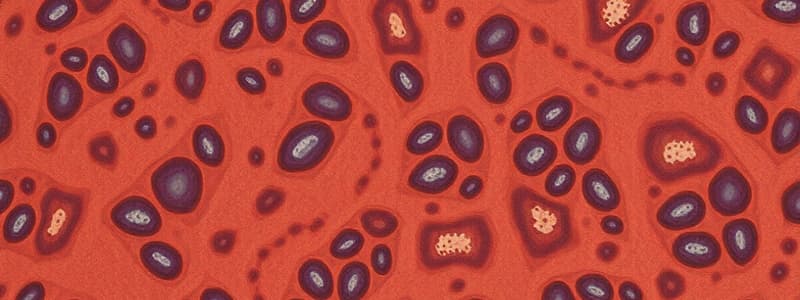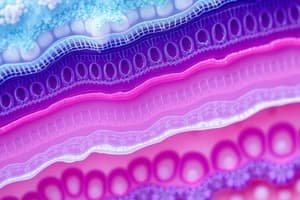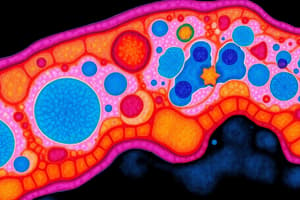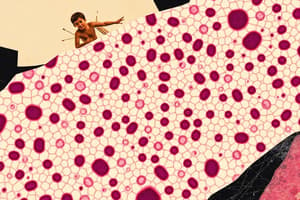Podcast
Questions and Answers
What is the primary function of superficial layers in the urinary bladder?
What is the primary function of superficial layers in the urinary bladder?
- Facilitate gas exchange
- Allow for secretion of urine
- Allow distension without rupturing (correct)
- Protect against pathogens
Which type of gland is characterized by the absence of a duct system?
Which type of gland is characterized by the absence of a duct system?
- Multicellular gland
- Endocrine gland (correct)
- Exocrine gland
- Mixed gland
Which of the following glands is classified as a mixed gland?
Which of the following glands is classified as a mixed gland?
- Goblet cell
- Adrenal gland
- Liver (correct)
- Salivary gland
What is the primary characteristic of unicellular glands like goblet cells?
What is the primary characteristic of unicellular glands like goblet cells?
What feature makes goblet cells distinguishable when stained with H&E?
What feature makes goblet cells distinguishable when stained with H&E?
What type of epithelial tissue is characterized by multiple layers of cells, where the surface cells are flat?
What type of epithelial tissue is characterized by multiple layers of cells, where the surface cells are flat?
In which locations would you typically find stratified squamous non-keratinized epithelium?
In which locations would you typically find stratified squamous non-keratinized epithelium?
What type of epithelial tissue is found lining the urinary bladder, allowing for changes in thickness?
What type of epithelial tissue is found lining the urinary bladder, allowing for changes in thickness?
What distinguishes keratinized from non-keratinized stratified squamous epithelium?
What distinguishes keratinized from non-keratinized stratified squamous epithelium?
What is the main characteristic of the superficial layer of transitional epithelium when the bladder is full?
What is the main characteristic of the superficial layer of transitional epithelium when the bladder is full?
What type of cells make up the basal layer of stratified squamous non-keratinized epithelium?
What type of cells make up the basal layer of stratified squamous non-keratinized epithelium?
Which type of epithelial tissue is typically found in the respiratory tract?
Which type of epithelial tissue is typically found in the respiratory tract?
Which typing of epithelial tissue typically has eight or more layers when the bladder is empty?
Which typing of epithelial tissue typically has eight or more layers when the bladder is empty?
Flashcards
Glandular Epithelium
Glandular Epithelium
Epithelial tissue specialized for secretion, classified by the presence or absence of a duct.
Exocrine gland
Exocrine gland
Glands that release secretions through a duct system, like salivary glands.
Endocrine gland
Endocrine gland
Glands that release secretions directly into the bloodstream, like the adrenal gland and pituitary gland.
Mixed gland
Mixed gland
Signup and view all the flashcards
Unicellular gland
Unicellular gland
Signup and view all the flashcards
Stratified epithelium
Stratified epithelium
Signup and view all the flashcards
Stratified squamous non-keratinized epithelium
Stratified squamous non-keratinized epithelium
Signup and view all the flashcards
Stratified squamous keratinized epithelium
Stratified squamous keratinized epithelium
Signup and view all the flashcards
Transitional epithelium
Transitional epithelium
Signup and view all the flashcards
Basal layer
Basal layer
Signup and view all the flashcards
Intermediate layers
Intermediate layers
Signup and view all the flashcards
Superficial layers
Superficial layers
Signup and view all the flashcards
Stratified squamous keratinized epithelium (Special case)
Stratified squamous keratinized epithelium (Special case)
Signup and view all the flashcards
Study Notes
Epithelial Tissue Overview
- Epithelial tissue forms linings and coverings of body surfaces and forms glands
- Classified based on shape and arrangement of cells
- Two main types: covering and lining epithelium and glandular epithelium
Covering and Lining Epithelium
- Further classified into simple and stratified
Simple Epithelium
- Single layer of cells
- Function in absorption, secretion, filtration, and diffusion
- Types:
- Squamous: thin, flat cells
- Cuboidal: cube-shaped cells
- Columnar: column-shaped cells
- Pseudostratified columnar: appears layered but is single layer
Stratified Epithelium
- Multiple layers of cells
- Provides protection
- Types:
- Stratified squamous: multiple layers of flat cells
- Keratinized: outer layers of dead cells (e.g., skin)
- Non-keratinized: outer layers of living cells (e.g., mouth, vagina)
- Stratified cuboidal: multiple layers of cube-shaped cells
- Stratified columnar: multiple layers of column-shaped cells
- Transitional: specialized for stretching , varying shape based on fullness (e.g., urinary bladder)
- Stratified squamous: multiple layers of flat cells
Glandular Epithelium
- Specialized for secretion
- Classified into:
- Exocrine glands: secrete products into ducts or onto surfaces
- Unicellular glands: single cells (e.g., goblet cells)
- Multicellular glands: composed of many cells
- Endocrine glands: secrete products directly into the bloodstream
- Lack ducts
- Examples include adrenal glands, pituitary glands, pancreas, and liver
- Exocrine glands: secrete products into ducts or onto surfaces
Stratified Squamous Epithelium
- Structure:
- Basal layer: single layer of columnar cells
- Intermediate layers: polyhedral cells with spherical nuclei
- Superficial layers: flat cells with elongated nuclei
- Locations (non-keratinized):
- Mouth, Esophagus, Anal canal, Vagina, Cornea
- Locations (keratinized):
- Epidermis of skin, Hard palate, Oral cavity of ruminants, Dorsal surface of the tongue
Transitional Epithelium
- Structure:
- Varying appearance based on tissue stretching
- Fewer layers of cells when expanded
- Cells in the superficial layer of empty bladder are dome shaped
- Cells in the superficial layer of full bladder are rounded and flattened.
- Varying appearance based on tissue stretching
- Location: urinary passages (renal pelvis, urinary bladder, ureter)
Glandular Epithelium Types
- Exocrine glands: have ducts to carry secretions to surface or cavities
- Endocrine glands: do not have ducts, secrete directly into bloodstream
- Mixed glands: contain both exocrine and endocrine functions
Unicellular Glands
- Single celled glands
- Examples include goblet cells, which secrete mucus.
Details on Goblet Cells
- Unicellular glands that produce glycoproteins (mucus)
- Found in respiratory and digestive systems
- Upper part of cell is foamy due to secretory granules
- Lower part contains the nucleus
Studying That Suits You
Use AI to generate personalized quizzes and flashcards to suit your learning preferences.




